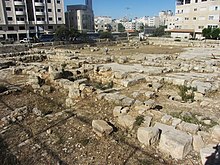
Back ممرا ARZ Mamre Catalan Mamre German Mamre Spanish مامره Persian אלוני ממרא HE Mamre ID Mamre Polish Mamre Portuguese Мамре Russian
 Archaeological remains at Ramat el-Khalil | |
| Alternative name | Mambre. For Ramat el-Khalil site: Ramat el-Khalil, Ramet el-Khalil (Rāmet el-Ḥalīl), Haram Ramet el-Khalil, Beit Khalil er-Rahman, Beit el-Khalil ('Abraham's House')[1][2][3][4] |
|---|---|
| Location | Judea, West Bank, Hebron area |
| Coordinates | 31°33′24″N 35°06′19″E / 31.556536°N 35.105336°E |
| History | |
| Founded | Ramat el-Khalil site: doubtful according to latest data: 9th–8th century BCE, Kingdom of Judah;[5] 1st century BCE, Herod the Great; 130 CE, Emperor Hadrian; 324 CE, Constantine the Great;[6] doubtful: 12th century, Crusaders[6][2][7] |
| Site notes | |
| Archaeologists | Ramat el-Khalil: Andreas Evaristus Mader (1926–1928), Sayf al-Din Haddad (1977), 'Abd el-Aziz Arjub (1984–1985),[2] Yitzhak Magen (1986–1988)[8] |
Mamre (/ˈmæmri/; Hebrew: מַמְרֵא), full Hebrew name Elonei Mamre, 'Oaks of Mamre', refers to an ancient religious site originally focused on a single holy tree, growing "since time immemorial" at Hebron in Canaan.[9] At its first location, Khirbet Nimra, a pagan tree cult predated the biblical narrative.[10] It is best known from the biblical story of Abraham and the three visitors.[11] The tree under which he had pitched his tent is known as the oak or terebinth of Mamre. Modern scholars have identified three sites near Hebron which, in different historical periods, have been successively known as Mamre: Khirbet Nimra (a little excavated Persian and Hellenistic period site), Ramat el-Khalil (the best known site, flourished from the Herodian through the Byzantine period), and Khirbet es-Sibte. The last one contained an old oak tree identified by a relatively new tradition as the Oak of Mamre, which has collapsed in 2019, and is on the grounds of a Russian Orthodox monastery.
Jewish-Roman historian Josephus, as well as Christian and Jewish sources from the Byzantine period, locate Mamre at the site later renamed in Arabic as Ramat el-Khalil, 4 km north of historical Hebron and approximately halfway between that city and Halhul. Herod the Great apparently initiated the Jewish identification of the site with Mamre, by erecting there a monumental enclosure. It was one of the three most important "fairs" or market places in Judea, where the fair was held next to the venerated tree, accompanied by an interdenominational festival joined in time by Jews, pagans, and Christians. This prompted Emperor Constantine the Great to unsuccessfully attempt at putting a stop to this practice by erecting a Christian basilica there.
- ^ Macpherson (1895), p.33–34, fn. 1.
- ^ a b c Greenberg & Keinan (2009)
- ^ Jericke (2003), p. 1
- ^ Magen, Duval, Donner, Bagatti, Di Segni (2000)
- ^ Drbal (2017)
- ^ a b Negev & Gibson (2001)
- ^ Cite error: The named reference
Pringle1998was invoked but never defined (see the help page). - ^ Stephen Langfur, Byzantine Mamre
- ^ Niesiolowski-Spano (2016).
- ^ Heyden (2016)
- ^ Genesis 18:1–8
© MMXXIII Rich X Search. We shall prevail. All rights reserved. Rich X Search
